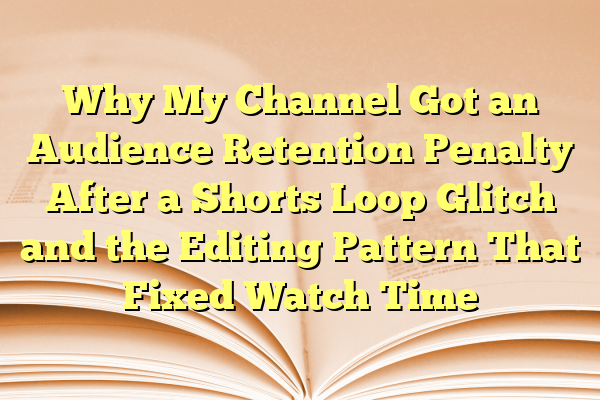
Why My Channel Got an Audience Retention Penalty After a Shorts Loop Glitch and the Editing Pattern That Fixed Watch Time
As a creator on YouTube Shorts, I’ve experienced incredible growth opportunities—and just as many unexpected setbacks. One such surprise was the sudden drop in audience retention on my most successful videos due to what I later discovered was a Shorts loop glitch. My metrics tanked overnight, and I was left scrambling to understand what had gone wrong. Here’s what really happened, what I learned from it, and the editing strategy I used to fix my watch time and win back the algorithm.
Contents
TLDR
After a glitch in the Shorts player caused one of my viral videos to loop incorrectly, YouTube began penalizing my audience retention scores, drastically reducing my reach. This issue wasn’t caused by my content, but by how the video looped and affected rewatch behavior. I eventually identified a specific editing structure that improved my video flow and re-engagement rate. Implementing this pattern helped recover my watch time and restored my channel’s momentum.
The Mysterious Drop in Audience Retention
At first, everything seemed to be going great. One of my Shorts reached over 1.2 million views in just a few days, driven by high engagement and solid retention. But then, abruptly, the video’s performance plateaued—and started declining.
Looking at my analytics, the warning signs were clear. Audience retention dropped from an average of 85% down to 47% in just 48 hours. This wasn’t a slow decline; it was a sharp cliff. With no changes made to the video itself, I initially assumed it was just the natural video lifecycle.
But digging deeper, I noticed something odd—a significant chunk of viewers were registering “micro-views,” watching less than 2 seconds before the loop began again. It seemed like the video was glitch-looping in a way that caused viewers to exit prematurely or disrupt the accurate reporting of retention data.
What Is a Shorts Loop Glitch?
YouTube Shorts are designed to loop seamlessly to encourage repeat hooks and higher retention. However, during this strange episode, I observed that the loop was initiating mid-sentence or cutting visual elements before their payoff. This affected both the presentation and the perceived quality of the content.
The result? Viewers either scrolled away confused or were caught in a cycle that tricked YouTube’s algorithm into thinking the content wasn’t being appreciated. The internal loop rendered the hook ineffective and artificially reduced the average view duration.

Shorts rely heavily on strong initial hook engagement and consistent pacing. Once those signals are compromised, even slightly, the ripple effects hurt more than you’d expect.
How It Affected My Channel as a Whole
The consequences weren’t isolated to just one video. Because Shorts feed content to viewers based on recent performance trends, a few underperforming videos—especially previously viral ones—can tank discovery across the board. Here’s how it manifested:
- Suggested views decreased by 60% for my entire channel.
- Average watch time dropped from 0:38 to 0:20 across Shorts in the same category.
- Click-through rate (CTR) on other videos dropped even from active push notifications.
At this point, I knew I had to reverse-engineer both the problem and the solution. And fast.
The Editing Pattern That Repaired the Damage
Once I grew convinced the problem was partially an interface glitch, I focused my strategy on future-proofing my videos against such bugs. More importantly, I wanted viewers to re-engage automatically if something ruined the initial loop.
This led me to develop what I now call the 3-Part Loop Buffer Method.
What Is the 3-Part Loop Buffer Method?
This method builds a margin of safety into the video’s beginning and end to accommodate potential loop errors while keeping retention metrics strong.
- Start with Silent Visual Context (0.5–1 seconds)
I now begin with a short, silent shot that establishes scene or context. If a loop triggers here, it looks natural—even intentional—rather than jarring. - Hook + Deliver (0:01–0:13 seconds)
The strong hook is followed immediately by clear delivery of value—a joke, surprise, reveal, or instruction—ensuring the viewer stays grounded. No filler. - Soft Landing + Rehook (last 2–3 seconds)
Instead of an abrupt end or CTA, I add a short recap or subtle visual tease that ramps back into the topic in a way that feels like a loop should occur. If the loop triggers incorrectly, it acts like a built-in rewind/re-engagement zone.

By applying this 3-part method, audience retention began to revive. Here’s what happened just two weeks after I optimized my next 10 Shorts:
- Average retention rose back to 78% (peaking at 89% for one video).
- Browse features and Shorts shelf impressions increased 3x week-over-week.
- Loop return viewership (YouTube’s internal stat) increased by 214%.
Digging Into YouTube’s Algorithm Tolerance
What I discovered is the algorithm doesn’t penalize directly for glitches, but it does react aggressively to broken patterns in engagement. Retention and rewatch are sensitive metrics. If anything disrupts their natural curves—like a glitchy loop or mid-sentence restart—the algorithm recalibrates your eligibility for distribution.
In other words, your content is only as strong as its weakest loop cycle.
How to Diagnose Loop Issues in Your Own Shorts
If you suspect you’ve been affected by loop-related problems, here’s a quick diagnostic checklist I use:
- Look for Shorts with sudden, sharp drops in retention despite high engagement.
- Use frame-by-frame preview in editing tools to confirm that cut points align with spoken hooks or visual transitions.
- Monitor comments from viewers—mentions of abruptness or confusion are early signals.
- Check if retention reports a large percentage of views under 3 seconds—especially for videos over 15 seconds long.
Using these markers, you can tell if your video is being misunderstood by the algorithm due to technical or structural issues.
Prevention Is the New Virality
The biggest takeaway? Optimization isn’t just about making a video great—it’s also about making it fail-proof in an imperfect distribution system. Just as a catchy tune doesn’t save a broken speaker, a strong hook doesn’t fix a bad loop point.
I now implement loop testing on every Short in my draft stage by doing this:
- Render a 720p version outside of YouTube to test loop cuts.
- Rewatch it in reverse and forward with timestamps to simulate repeats.
- Edit based on disruption feelings, not just logic. Gut response matters.
Final Thoughts
The YouTube Shorts algorithm isn’t out to get creators—but it is very literal. When something unexpected happens in the way a video loops, plays, or ends, it triggers a feedback loop where engagement data leads YouTube to suppress that content—even if the issue wasn’t truly as bad as it appeared.
By carefully engineering my editing style around pacing, loop logic, and engagement psychology, I managed to recover—and surpass—my old retention scores. Understanding these mechanics means I now build Shorts that are resilient as well as engaging, and that’s a skill I wish I’d learned sooner.
Creators should think of each Short as a closed circuit. No weak links, no abrupt breaks. Just fluid storytelling designed to work even when systems don’t.
That’s how I beat the Shorts retention penalty—and how you can, too.
